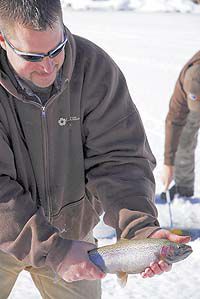| DWR biologist Justin Hart shows off a rainbow trout he recently caught at Scofield Reservoir while ice fishing. |
•Cleveland Reservoir. Todd Munford of King’s Outdoor Sports indicates that access is difficult due to the snow pack, but well worth the effort. Todd suggests parking on the northeast side of the lake and fishing in the middle of the lake. The ice is 16-18 inches thick. The best bait is a 1/8 oz. Swedish pimple or Kastmaster, tipped with a wax worm. Fish in 10-20 feet of water and two cranks off the bottom. Todd urges patience and suggests that you stay in one place for at least an hour as the fish are roaming in schools. Once your bait is hit, expect fast action for about 10-15 minutes. Rainbows get up to 18 inches. Todd reports that a lot of fish won’t be caught, but those you catch are nice.
•Mammoth Reservoir. The ice is more than 14 inches thick, says Todd Munford of King’s Outdoor Sports. Bring along a shovel, since the snow pack is fairly deep in some areas. Todd suggests fishing off the east shoreline about 100 yards from shore. Try a 1/4 oz. green or chartreuse jig, tipped with a red shiner minnow or piece of nightcrawler. Jig often, jerking the bait up 6-12 inches, then let the jig settle. Hits are very light, and a lot of fish are missed. Tiger trout range from 12-16 inches. Conservation Officer Casey Mickelsen checked anglers last Friday. Anglers were having good success in 20-25 feet of water with jigs, tipped with nightcrawlers or chunks of chub or carp meat. Special regulations apply. Refer to the proclamation.
•Huntington State Park. The ice is three to five inches thick. Fishing has been slow.
•Joes Valley Reservoir. The reservoir has partially iced over. It’s that time of year when open water and/or ice conditions can change from day to day. Boat launching may be difficult. If you can launch a boat, Aquatics Manager Paul Birdsey recommends trolling with a 3-5 inch, brown/white, diving crankbait (such as a shad-imitating Rapala). For still-fishermen, Paul suggests using sonar to locate and anchor over underwater structure. Especially productive are underwater shelves on the edge of drop-offs. At such locations, try a 3/8 oz. hammered nickel spoon with a chartreuse stripe. Bait the spoon with a piece of chub meat. Special regulations apply. Please refer to the fishing proclamation.
•Millsite State Park. Conservation Officer Casey Mickelsen reports slow fishing. The reservoir remains mostly open.
•Scofield Reservoir. This water continues to rank as the number one ice fishing destination in central Utah. Good fishing continues, although some reports indicate a slowing trend. Lieutenant Carl Gramlich fished last Friday and reported slow fishing until 10 a.m. From 10-11:30 a.m., fishing was good. Carl fished in 10-12 feet of water with a chartreuse ice fly and worm. Carl fished one crank off the bottom and kept jigging the bait. Conservation Officer Mike Milburn fished last Thursday and confirmed slower fishing than a week earlier. Mike recommends that anglers try new locations and move around until better fishing is found. The ice was 8-9 inches thick. Biologist Nathan Sill and party fished on Saturday. Nathan used a slip float with a Kastmaster attractant about 12 inches above an ice fly, tipped with a nightcrawler. Nathan’s party caught rainbow trout up to 17 inches. Success was sporadic. Best fishing occurred from 8-9:30 a.m. and then from 10:30-11 a.m. The bite was consistently very light. Todd Munford from King’s Outdoor World reported very good fishing, especially along the east side. He suggests fishing in 10-12 feet of water and said that 7 a.m.-2 p.m. was the best time slot for him. Todd suggests fishing 6-inches off the bottom with a 1/8 oz. chartreuse paddle bug, tipped with a nightcrawler. Todd says that more fish will bite, if crawfish smelly jelly is applied to the paddle bug. Jigging every once in a while will enhance the chance of a strike, too. Rainbows were in the 14-18 inch class and weighed one and one half to two pounds.

